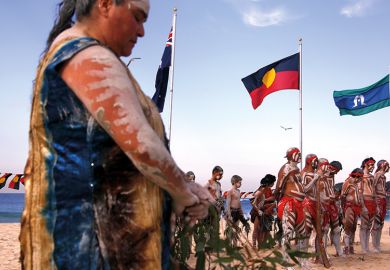A new Indigenous map of Canada made its parliamentary debut in Ottawa earlier this month. In place of provincial borders lie markings of green, purple and yellow, each one representing Indigenous territories. Also marked are the names of the traditional languages where they are commonly spoken – Cree languages, Inuktitut and Ojibway, alongside many more.
The map is one part of Canada’s response to its Truth and Reconciliation Commission, which recommended the creation of a “culturally appropriate” curriculum when it wrapped up in 2015.
It is also part of a recent history of governments around the world proving receptive to innovative approaches to peace and reconciliation.
Securing peace and reconciliation anywhere is an inherently complex pursuit. Yet it has fast become an issue that defines our time. Without it, countries are riven by conflict, communities are fragmented and people face undue suffering.
This year alone, France’s president, Emmanuel Macron, has made a landmark admission that the country used torture in the Algerian war, and South Africa’s president, Cyril Ramaphosa, has pledged to achieve greater land reform in order to overturn the economic dispossession of the majority black population caused by apartheid.
Historic injustices are also being explored in New Zealand and Australia, where regional cooperation has led to critical advancements in understanding the early colonial interactions between Aboriginal, Maori and settler communities.
This month, the Association of Commonwealth Universities launched the Peace and Reconciliation Network. This will provide resources and opportunities for higher education institutions to collaborate on research, teaching and learning and student and staff exchanges.
Bringing together common historical ties and diverse cultures, the network offers a global framework for progressive thinking, shared ideas and even joint action around higher education’s response to these challenges.
Serving as a connection with academics and universities across the world, the Peace and Reconciliation Network will allow the effective exchange of new ideas. The network provides the opportunity to critically examine institutional environments, to discuss the decolonisation of the curriculum, how to reform university policies and cultures to embrace people of diverse backgrounds, and the recognition of Indigenous pedagogies. For every university involved, it signals a commitment to building an institutional culture in which everyone has equal opportunity to achieve.
Through this commitment, universities recognise their obligations to society and their role as catalysts for change. The network, in turn, recognises the value of collaborative approaches and the free and open exchange of ideas.
Commonwealth members are overwhelmingly countries where land was expropriated, swindled and stolen from the legitimate owner. Land grabs soon led to the destruction of cultural practices, minority languages and Indigenous beliefs and forms of knowledge.
They also resulted in the huge, violent displacements of people – a result of the drawing of arbitrary borders. In India and Pakistan, maps from the pre-partition era are still being hidden from researchers and campaigners who are trying to uncover historic land rights.
Restoring land, culture and opportunity to Indigenous communities is therefore fundamental to successful peace and reconciliation. Importantly, remarkable work is underway. The Indigenous map in Canada is just one striking example. Prime minister Justin Trudeau began 2018 by promising the creation of a legal framework that guarantees – for the first time – the rights of Indigenous people in all government decisions.
In New Zealand, meanwhile, prime minister Jacinda Ardern has committed her progressive government to mending ties with the Māori community. She has also offered to take in refugees deported to Nauru by the Australian government. The latter has proven particularly popular when contrasted with official Australian policy, which grapples with the deportation of child refugees to detention camps on the Pacific island.
We could progress much further and faster if we could more easily learn from the approaches of others to peace and reconciliation. What’s more, having a network that could lead on applying these lessons in more recent post-conflict societies, such as Rwanda and Sierra Leone, could help to bring about life-changing results.
Early projects under consideration for the network are: building capacity for research into peace and reconciliation at ACU member institutions and securing international partnerships on matters such as shaping post-colonial curricula and the safeguarding of Indigenous languages.
In doing so, the network will connect resources, ideas and institutions so that communities across the world can look forward to more equitable futures.
The unveiling of the landmark Indigenous map in Ottawa this month highlighted how peace and reconciliation is intertwined so closely between the present and past. And while it will take more than truth-telling and recognition – it demands the integration of social and economic rights into the process – it was a step in the right direction.
We are determined that the Peace and Reconciliation Network will lead to countless more steps in the right direction.
Joanna Newman is chief executive and secretary general of the Association of Commonwealth Universities.
POSTSCRIPT:
Print headline: Mapping routes to peace
Register to continue
Why register?
- Registration is free and only takes a moment
- Once registered, you can read 3 articles a month
- Sign up for our newsletter
Subscribe
Or subscribe for unlimited access to:
- Unlimited access to news, views, insights & reviews
- Digital editions
- Digital access to THE’s university and college rankings analysis
Already registered or a current subscriber?



